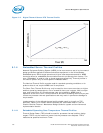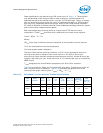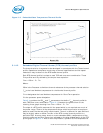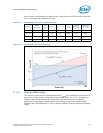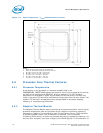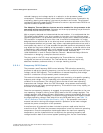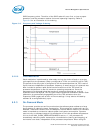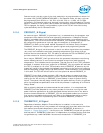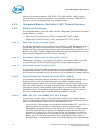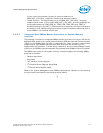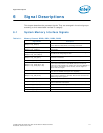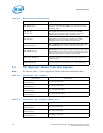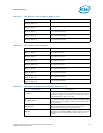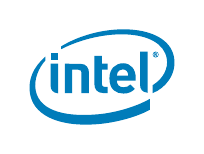
Intel® Xeon® Processor E5-1600 v2/E5-2600 v2 Product Families 113
Datasheet Volume One of Two
Thermal Management Specifications
Demand mode, the duty cycle of the clock modulation is programmable via bits 3:0 of
the same IA32_CLOCK_MODULATION MSR. In On-Demand mode, the duty cycle can
be programmed from 6.25% on / 93.75% off to 93.75% on / 6.25% off in 6.25%
increments. On-Demand mode may be used in conjunction with the Adaptive Thermal
Monitor; however, if the system tries to enable On-Demand mode at the same time the
TCC is engaged, the factory configured duty cycle of the TCC will override the duty
cycle selected by the On-Demand mode.
5.2.4 PROCHOT_N Signal
An external signal, PROCHOT_N (processor hot), is asserted when the processor core
temperature has reached its maximum operating temperature. If Adaptive Thermal
Monitor is enabled (note it must be enabled for the processor to be operating within
specification), the TCC will be active when PROCHOT_N is asserted. The processor can
be configured to generate an interrupt upon the assertion or de-assertion of
PROCHOT_N. Refer to the
Intel® Xeon® Processor E5 v2 Product Family Processor
Datasheet, Volume Two: Registers
for specific register and programming details.
The PROCHOT_N signal is bi-directional in that it can either signal when the processor
(any core) has reached its maximum operating temperature or be driven from an
external source to activate the TCC. The ability to activate the TCC via PROCHOT_N can
provide a means for thermal protection of system components.
As an output, PROCHOT_N will go active when the processor temperature monitoring
sensor detects that one or more cores has reached its maximum safe operating
temperature. This indicates that the processor Thermal Control Circuit (TCC) has been
activated, if enabled. As an input, assertion of PROCHOT_N by the system will activate
the TCC, if enabled, for all cores. TCC activation due to PROCHOT_N assertion by the
system will result in the processor immediately transitioning to the minimum frequency
and corresponding voltage (using Freq/SVID control). Clock modulation is not activated
in this case. The TCC will remain active until the system de-asserts PROCHOT_N.
PROCHOT_N can allow voltage regulator (VR) thermal designs to target maximum
sustained current instead of maximum current. Systems should still provide proper
cooling for the VR, and rely on PROCHOT_N as a backup in case of system cooling
failure. The system thermal design should allow the power delivery circuitry to operate
within its temperature specification even while the processor is operating at its Thermal
Design Power.
With a properly designed and characterized thermal solution, it is anticipated that
PROCHOT_N will be asserted for very short periods of time when running the most
power intensive applications. An under-designed thermal solution that is not able to
prevent excessive assertion of PROCHOT_N in the anticipated ambient environment
may cause a noticeable performance loss. Refer to the appropriate platform design
guide and for details on implementing the bi-directional PROCHOT_N feature.
5.2.5 THERMTRIP_N Signal
Regardless of whether Adaptive Thermal Monitor is enabled, in the event of a
catastrophic cooling failure, the processor will automatically shut down when the silicon
has reached an elevated temperature (refer to the THERMTRIP_N definition in
Chapter 6, “Signal Descriptions”). At this point, the THERMTRIP_N signal will go active
and stay active. THERMTRIP_N activation is independent of processor activity and does
not generate any Intel®
QuickPath Interconnect transactions. If THERMTRIP_N is




